- Home
- Medical news & Guidelines
- Anesthesiology
- Cardiology and CTVS
- Critical Care
- Dentistry
- Dermatology
- Diabetes and Endocrinology
- ENT
- Gastroenterology
- Medicine
- Nephrology
- Neurology
- Obstretics-Gynaecology
- Oncology
- Ophthalmology
- Orthopaedics
- Pediatrics-Neonatology
- Psychiatry
- Pulmonology
- Radiology
- Surgery
- Urology
- Laboratory Medicine
- Diet
- Nursing
- Paramedical
- Physiotherapy
- Health news
- Fact Check
- Bone Health Fact Check
- Brain Health Fact Check
- Cancer Related Fact Check
- Child Care Fact Check
- Dental and oral health fact check
- Diabetes and metabolic health fact check
- Diet and Nutrition Fact Check
- Eye and ENT Care Fact Check
- Fitness fact check
- Gut health fact check
- Heart health fact check
- Kidney health fact check
- Medical education fact check
- Men's health fact check
- Respiratory fact check
- Skin and hair care fact check
- Vaccine and Immunization fact check
- Women's health fact check
- AYUSH
- State News
- Andaman and Nicobar Islands
- Andhra Pradesh
- Arunachal Pradesh
- Assam
- Bihar
- Chandigarh
- Chattisgarh
- Dadra and Nagar Haveli
- Daman and Diu
- Delhi
- Goa
- Gujarat
- Haryana
- Himachal Pradesh
- Jammu & Kashmir
- Jharkhand
- Karnataka
- Kerala
- Ladakh
- Lakshadweep
- Madhya Pradesh
- Maharashtra
- Manipur
- Meghalaya
- Mizoram
- Nagaland
- Odisha
- Puducherry
- Punjab
- Rajasthan
- Sikkim
- Tamil Nadu
- Telangana
- Tripura
- Uttar Pradesh
- Uttrakhand
- West Bengal
- Medical Education
- Industry
Study finds risk factors for vertebral fractures and bone loss after denosumab discontinuation

Denosumab reduces bone resorption and improves bone mineral density (BMD). A recent study suggests that the age, treatment duration, and prior bisphosphonate therapy are all associated with potential bone mineral density (BMD) loss following the discontinuation of denosumab therapy. The study findings were published in the journal Bone on December 26, 2020.
Unlike bisphosphonates, denosumab is not incorporated into the bone. Therefore, its effect on bone resorption stops after treatment discontinuation. Denosumab discontinuation without subsequent bisphosphonates (BPs) is associated with bone loss and multiple vertebral fractures. However, the risk factors of bone loss and multiple fractures remain unclear. Therefore, researchers of Switzerland conducted a study to identify the risk factors for bone loss and vertebral fractures after denosumab discontinuation.
It was a retrospective study of 219 women with osteoporosis who discontinued denosumab treatment and received subsequent treatment with zoledronate, other BPs or a selective estrogen receptor modulator (SERM), or no therapy. Researchers analyzed the fracture rate, longitudinal bone mineral density (BMD) changes and bone turnover markers (BTMs) within 2years after denosumab discontinuation. They used the linear regression model, to evaluate the loss of BMD and age, BMI (kg/m2), denosumab treatment duration, pre-treatment, prior fracture state, baseline T-scores, use of glucocorticoids or aromatase inhibitors and BMD gains under denosumab therapy.
Key findings of the study were:
♦ Among 219 women, 171 received zoledronate after denosumab discontinuation, 26 had no subsequent treatment and 22 received other therapies (other BPs or a SERM).
♦Upon analysis, researchers found that zoledronate was associated with the fewest vertebral fractures (hazard ratio 0.16), and all subsequent therapies retained BMD at all sites to some extent.
♦ They also found that higher BMD loss was associated with younger age, lower BMI, longer denosumab treatment, lack of prior antiresorptive treatment and BMD gain under denosumab treatment.
♦ They noted that the BTM levels correlated with denosumab treatment duration and bone loss at the total hip but not the lumbar spine.
♦ These findings imply:
- Vertebral fractures after denosumab discontinuation were low with subsequent therapy.
- Pre-treatment with BPs, such as zoledronate, is associated with fewer vertebral fractures.
- Longer denosumab treatment was associated with increased bone loss afterwards.
- Higher BMD gains under treatment correlated with BMD loss upon discontinuation.
The authors concluded, "Compared to no subsequent therapy, zoledronate was associated with fewer vertebral fractures after denosumab. Further, BMD loss depended on denosumab treatment duration, age, prior BP therapy and BMD gain under denosumab therapy, whereas BTM levels were associated with bone loss at the total hip and denosumab treatment duration."
For further information:
Medical Dialogues Bureau consists of a team of passionate medical/scientific writers, led by doctors and healthcare researchers. Our team efforts to bring you updated and timely news about the important happenings of the medical and healthcare sector. Our editorial team can be reached at editorial@medicaldialogues.in.
Dr Kamal Kant Kohli-MBBS, DTCD- a chest specialist with more than 30 years of practice and a flair for writing clinical articles, Dr Kamal Kant Kohli joined Medical Dialogues as a Chief Editor of Medical News. Besides writing articles, as an editor, he proofreads and verifies all the medical content published on Medical Dialogues including those coming from journals, studies,medical conferences,guidelines etc. Email: drkohli@medicaldialogues.in. Contact no. 011-43720751


